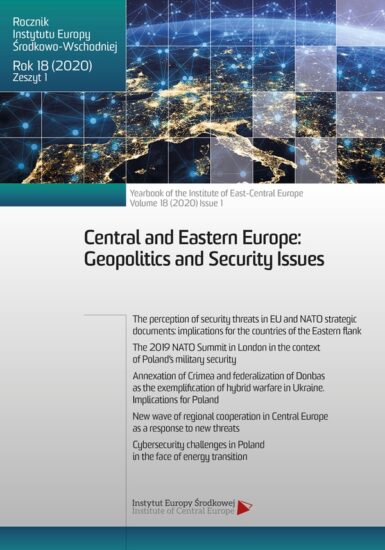Central and Eastern Europe: Imaginary Geographies, Geopolitics and Security Issues
Bauman, Z., ‘What is Central in Central Europe?’, in: Yet Another Europe After 1984: Rethinking Milan Kundera and the Idea of Central Europe, ed. L. Donskis, Value Inquiry Book Series, Amsterdam: Brill, Rodopi, 2012.
Bayer, L., ‘How Orban broke the EU and got away with it’, Politico, 24 September 2020, https://www.politico.eu/article/how-viktor-orban-brokethe-eu-and-got-away-with-it-hungary-rule-of-law/.
Blokker, P., ‘The Ruins of a Myth or a Myth in Ruins? Freedom and Cohabitation in Central Europe’, in: The Inhabited Ruins of Central Europe, eds. D. Gafijczuk, D. Sayer, London: Palgrave Macmillan, 2013.
Bodnar, J., ‘Shamed by Comparison. Eastern Europe and the Rest’, in: EUtROPEs. The Paradox of European Empire, eds. J.W. Boyer, B. Molden, Parisian Notebooks, no. 7, Paris, France, Chicago, Illinois, 2014.
Bokajło, J., ’Polish energy strategy – in the quest for economy. Reflections on the Polish energy policy in the perspective of endogenous growth theory and global trends within the context of Visegrad cooperation’, Yearbook of the Institute of East-Central Europe, vol. 18, no. 1, 2020.
Buras, P., ‘Dylematy państwa status quo. Nowa kwestia niemiecka w Europie’, Sprawy Międzynarodowe, LXVII, no. 4, 2014.
Davies, N., God’s Playground. A History of Poland. The Origins to 1795, New York: Columbia University Press, 2005.
De La Baume, M., ‘Poland Joins Hungary in threatening to block EU’s budget and Coronavirus Recovery Package’, Politico, 18 September 2020, https://www.politico.eu/article/poland-joins-hungary-in-threat-to-block-euslandmark-budget-and-recovery-package/.
Dempsey, J., ‘Doubletake. Does Russia Divide Europe?’, New Eastern Europe, no. 5, September-October 2015.
Dhand, O., The Idea of Central Europe: Geopolitics, Culture and Regional identity, London: I.B. Tauris, 2018.
Fedorowicz, K., ‘Ukraińskie rewolucje a parlamentaryzm’, Rocznik Instytutu Europy Środkowo-Wschodniej, vol. 12, no 2, 2014.
Ganesh, B., Froio, C., ‘A “Europe des Nations”: far right imaginative geographies and the politicization of cultural crisis on Twitter in Western Europe’, Journal of European Integration, no. 42, vol. 5, 2020.
Gawron-Tabor, K., ‘Challenges and threats to the security of the Visegrad Group countries: intensification of relations with the United States as a means to overcome risks?’, Yearbook of the Institute of East-Central Europe, vol. 18, no. 1, 2020.
Gehrke, L., ‘The two countries say they want to ensure they’re not treated unfairly under Brussels’ double standards’, Politico, 29 September 2020, https://www.politico.eu/article/poland-and-hungary-charge-brusselswith-double-standards-on-rule-oflaw/?fbclid=IwAR0w93XxDPLbFyq6q993GU3bAJ7nwclRNfq2fhNmgmgkBIR4d5qOkrU62W8.
‘Jak Rosja chce wrócić z peryferii do centrum globalizacji. Rozmowa z rosyjskim politologiem Dmitrjem Treninem’, Europa. Miesięcznik Idei, no. 6, Fundacja im. Immanuela Kanta.
Jureńczyk, Ł., ‘The 2019 NATO Summit in London in the context of Poland’s military insecurity’, Yearbook of the Institute of East-Central Europe, 2020, vol. 18, no. 1.
Krastev, I., ‘How to Avoid Europe’s Disintegration’, New Eastern Europe, no. 5, September–October 2015.
Kucharska, A., ‘Cybersecurity challenges in Poland in the face of energy transision’, Yearbook of the Institute of East-Central Europe, vol. 18, no. 1, 2020.
Laurelle, M., Rivera, E., ‘Imagined Geographies of Central and Eastern Europe. The Concept of Intermarium’, IERES Occasional Papers, Transnational History of the Far Right Series, no. 1, March 2019, https://www.illiberalism.org/imagined-geographies-of-central-and-eastern-europethe-concept-of-intermarium/.
Menkiszak, M., ‘A strategic continuation, a tactical change. Russia’s European security policy’, OSW Point of View, no. 76, October 2019.
Mignolo, W.D., Walsh, C.E., On Decoloniality. Concepts, Analytics, Praxis, Durham: Duke University Press, 2018.
Nitoiu, C., Sus, M., ‘Introduction: The Rise of Geopolitics in the EU’s Approach in its Eastern Neighbourhood’, Geopolitics, vol. 1, no. 24, 2019.
‘Obama, Clinton, Putin, Merkel, Kaczyński… Jak urządzą nam świat w 2016’, Gazeta Wyborcza/Magazyn Świąteczny, 2 January 2016, http://wyborcza.pl/magazyn/1,149896,19419244,obama-clinton-putin-merkel-kaczynski-jak-urzadza-nam.html.
Orzechowski, M., Jartyś, J., ‘Annexation of Crimea and federalization of Donbas as the exemplification of hybrid warfare in Ukraine. Implications for Poland’, Yearbook of the Institute of East-Central Europe, vol. 18, no. 1, 2020.
Orzelska-Stączek, A., ‘New wave of regional cooperation in Central Europe as a response to new threats’, Yearbook of the Institute of East-Central Europe, vol. 18, no. 1, 2020.
Paulovicova, N., ‘The far right ĽSNS in Slovakia and its reconstruction of the nation’, Yearbook of the Institute of East-Central Europe, vol. 18, no. 1, 2020.
Rotfeld, A.D., ‘Porządek międzynarodowy. Parametry zmiany’, Sprawy Międzynarodowe, no. 4(LXVII), 2014,, p. 37.
Russia as Civilization, eds. K. Mjør, S. Turoma, London: Routledge, 2020. Sakwa, R., Frontline Ukraine. Crisis in the Borderlands, London-New York: I.B. Tauris, 2015.
Speck, U., ‘Power and Purpose. German Foreign Policy at a Crossroads’, Carnegie Europe, 3 November 2014, http://carnegieeurope.eu/2014/11/03/power-and-purpose-german-foreign-policy-at-crossroads.
Stępniewski, T., ‘The EU’s Eastern Partnership and the Way Forward After Riga’, International Issues & Slovak Foreign Policy Affairs, vol. XXIV, no. 1-2, 2015.
Rocznik Instytutu Europy Środkowo-Wschodniej, eds. T. Stępniewski, A. Gil, A. Szabaciuk, A. Visvizi, vol. 12, no. 2, 2014.
Sykulski, L., ‘Russian geopolitical doctrine of “Velikiy Limitrof” ’, European Journal of Geopolitics, no.7, 2019.
Szabaciuk, A., ‘On the Verge of a New Cold War? The Anti-Western Dimension of Vladimir Putin’s Eurasian Integration Project’, Rocznik Instytutu Europy Środkowo-Wschodniej, vol. 11, no. 6, 2013.
Szewcowa, L., ‘Polem gry Kremla jest chaos’, trans. A. Ehrlich, Gazeta Wyborcza/Magazyn Świąteczny, 27 June 2015, http://wyborcza.pl/magazyn/1,145325,18248326,Polem_gry_Kremla_jest_chaos.html#TRwknd.
Szücs, J., ‘The Three Historic Regions of Europe, An Outline’, Acta Historica Scientiarum Hungaricae, vol. 29 (2–4).
Todorova, M., Imagining the Balkans, Oxford: Oxford University Press, 2009.
Tsygankov, A.P., Russia’s Foreign Policy. Change and Continuity in National Identity, 2nd ed., Lanham 2010.
Vieten, U.M., Poynting, S., ‘Contemporary Far Right Racist Populism in Europe’, Journal of Intercultural Studies, no. 6 (37), 2016.
Zieliński, T., ‘The perception of security threats in EU and NATO strategic documents: implications for the countries of the Eastern flank’, Yearbook of the Institute of East-Central Europe, vol. 18, no. 1, 2020.


